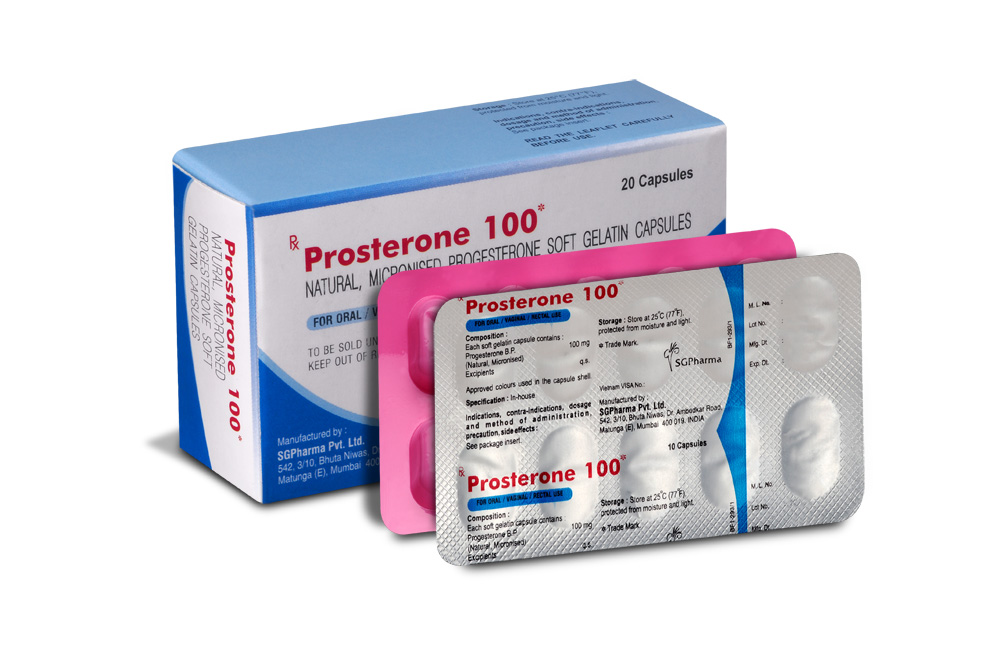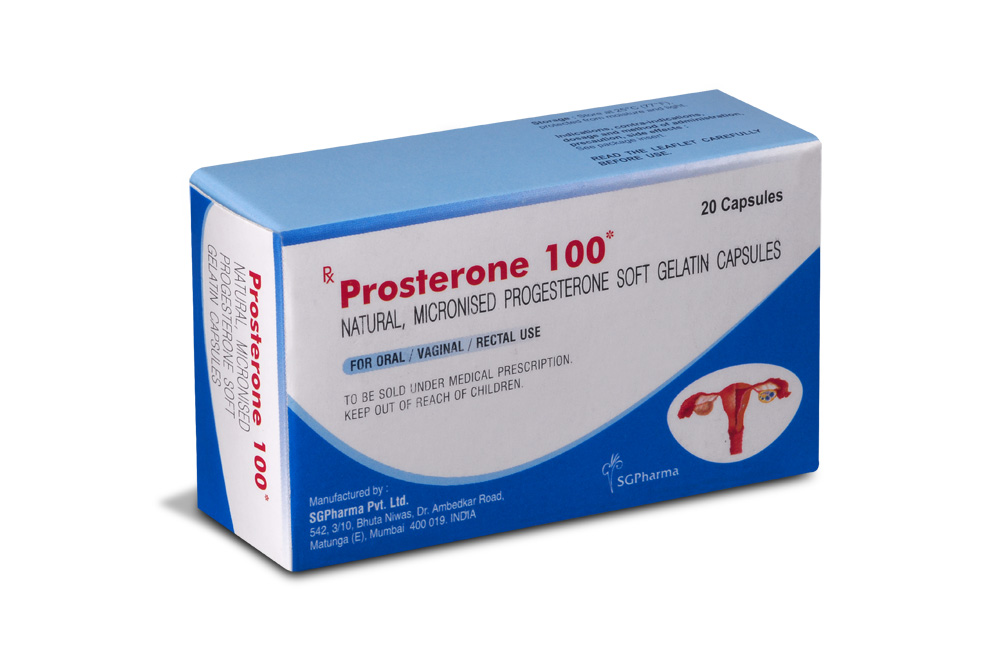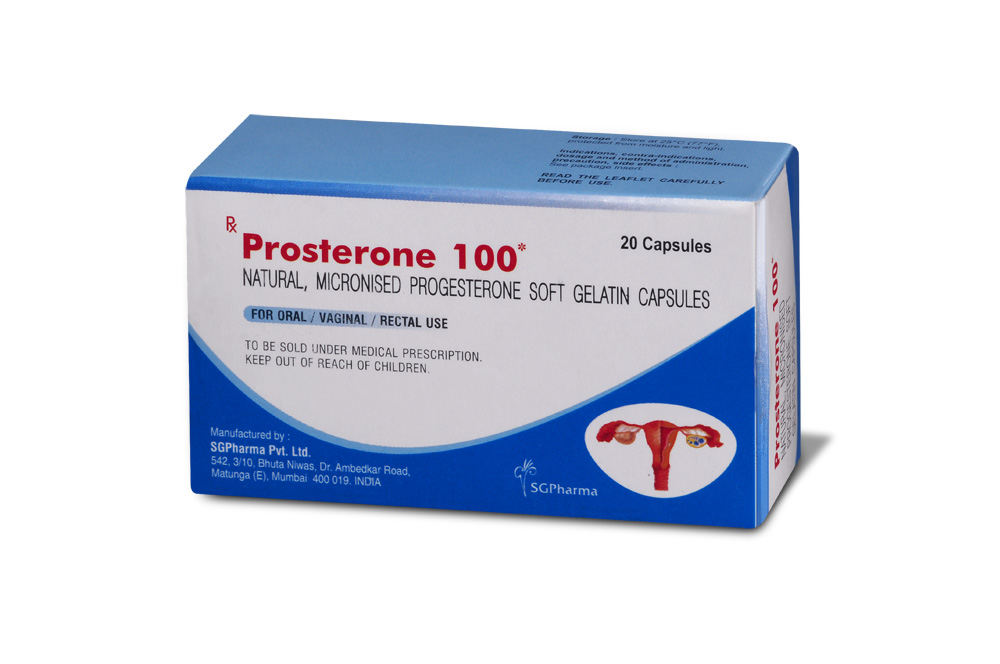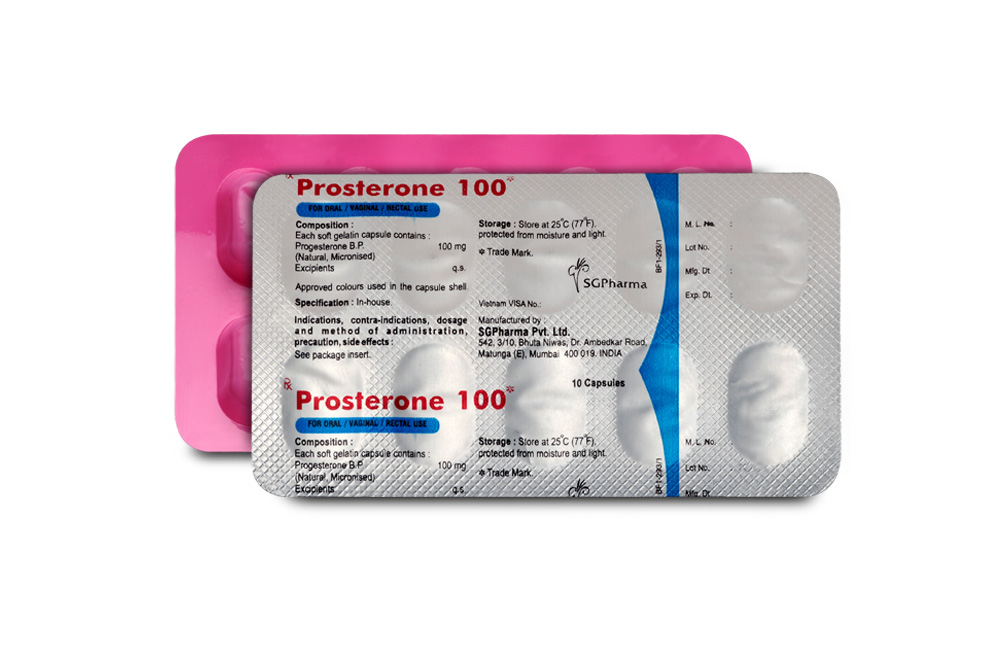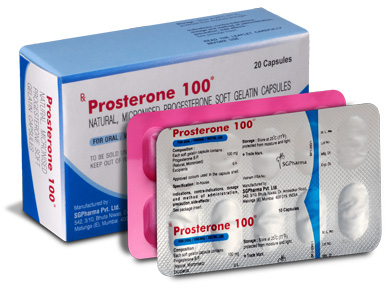
100 mg, 200 mg, 400 mg
For the use of a Registered Medical Practitioner or a Hospital or a Institution only.
Prosterone (Progesterone) is synthesized from a starting material from a plant source and is chemically identical to progesterone of human ovarian origin. Chemically, Progesterone is Pregn-4-ene-3, 20-dione. The molecular formula is C21H30O2 and molecular weight is 314.47.
STRUCTURAL FORMULA :
Its structural formula is :
-Structure.jpg)
Prosterone capsules are white to off white oval shaped soft gelatin capsules.
COMPOSITION :
Prosterone 100
Each soft gelatin capsule contains :
Progesterone B.P. 100 mg
(Natural, Micronised)
Excipients q.s.
Approved colours used in capsule shell.
Prosterone 200
Each soft gelatin capsule contains :
Progesterone B.P. 200 mg
(Natural, Micronised)
Excipients q.s.
Approved colours used in capsule shell.
Prosterone 400
Each soft gelatin capsule contains :
Progesterone B.P. 400 mg
(Natural, Micronised)
Excipients q.s.
Approved colours used in capsule shell.
ACTIONS :
Progesterone is a naturally occurring steroid that is secreted by the ovary, placenta and adrenal gland. In the presence of adequate oestrogen, progesterone transforms a proliferative endometrium into a secretory endometrium. Progesterone is necessary to increase endometrial receptivity for implantation of an embryo. Once an embryo is implanted, progesterone acts to maintain a pregnancy.
PHARMACOKINETICS :
Absorption :
Vaginal / Rectal route :
Prosterone capsules are well absorbed when administered vaginally or rectally. Rectal or vaginal administration of 100 - 400 mg produces concentration in the luteal range which is maximal within 1 - 8 hours and then declines over a period of 24 hours.
Oral route :
After oral administration of progesterone as a micronised capsule formulation, maximum serum concentrations were attained within 3 hours. The absolute bioavailability of micronised progesterone is not known. Serum progesterone concentrations appeared linear.
Distribution :
Progesterone is approximately 90 % or more bound to serum proteins, primarily to serum albumin (79.3 %) and transcortin (17.70 %).
Metabolism :
Progesterone is metabolized primarily by the liver largely to pregnanediols and pregnanolones. Pregnanediols and pregnanolones are conjugated in the liver to glucuronide and sulfate metabolites. Progesterone metabolites which are excreted in the bile may be deconjugated and may be further metabolized in the gut via reduction, dehydroxylation and epimerization.
Excretion :
The glucuronide and sulfate conjugates of pregnanediol and pregnanolone are excreted in the bile and urine. Progesterone metabolites, which are excreted in the bile, may undergo enterohepatic recycling or may be excreted in the faeces.
INDICATIONS :
Vaginal / Rectal :
Supplementation of the luteal phase in case of sterility due to luteal deficiency, treatment of threatened abortion, treatment of puerperal depression, to help pregnancy.
Oral :
Disorders associated with deficiency to progesterone :
premenstrual syndrome, menstrual irregularities through dysovulation or ovulation, benign mastopathies, menopause (in addition to oestrogen treatment).
For oral/vaginal/rectal administration.
A] Vaginal/Rectal Administration :
Each Capsule should be deeply inserted in the vagina. Supplementation of the luteal phase in case of sterility due to progesterone deficiency : 400 - 600 mg per day starting with day of injection of HCG or ovulation up to the 12th week of pregnancy.
To help pregnancy and for the treatment of threatened abortion :
200 - 400 mg per day in single or divided doses.
For treatment of premenstrual syndrome :
Commence treatment on day 14 of menstrual cycle and continue treatment until onset of menstruation. If symptoms are present at ovulation commence treatment on day 12.
For the treatment of puerperal depression :
The recommended dosage is 200 - 400 mg per day in divided doses for 7 days after delivery. An alternative rectal administration should be considered whenever vaginal administration is not possible.
B] Oral :
Disorders associated with deficiency of progesterone in particular :
Premenstrual syndrome, Benign mastopathies, menstrual irregularities, pre menopause. 200 to 300 mg per day, 10 days per cycle, usually from 14th day until onset of menstruation.
Menopause :
One capsule of 200 mg per day in the evening for the last 14 days of oestrogen treatment per cycle. Oestrogen should be administered at the lowest effective dose. Patients being treated with high doses of oestrogen should be administered 300 mg of Prosterone capsules. In case of side effects with oral route of administration (such as drowsiness) or in case of severe hepatic disease, an alternative vaginal route of administration is recommended. [Note : Prosterone capsules should not be taken with food. It is recommended to use the capsules at intervals of one hour before or after the meals.]
CONTRAINDICATIONS :
Prosterone capsules are contraindicated in known sensitivity to progesterone or its ingredients, thrombophlebitis, thromboembolic disorders, cereberal apoplexy or patients with a past history of these conditions. Also contraindicated in severe liver dysfunction or disease, known or suspected malignancy of breast or genital organs, undiagnosed vaginal bleeding and missed abortion, as diagnostic test for pregnancy.
WARNINGS :
1. The physician should be alert to the earliest manifestations of thrombotic disorders (thrombophlebitis, cerebrovascular disorders, pulmonary embolism and retinal thrombosis). Should any of these occur or be suspected, the drug should be discontinued immediately.
2. Discontinue medication pending examination if there is sudden partial or complete loss of vision, or if there is a sudden onset of proptosis, diplopia or migraine. If examination reveals papilledema or retinal vascular lesions, medication should be withdrawn.
3. The administration of any drug to nursing mothers should be done only when clearly necessary since many drugs are excreted in human milk. Detectable amounts of progestin have been identified in the milk of mothers receiving progestins. The effect of this on the nursing infant has not been determined.
PRECAUTIONS :
General :
1. The pretreatment physical examination should include special reference to breast and pelvic organs, as well as Papanicolaou smear.
2. Because progesterone may cause some degree of fluid retention, conditions which might be influenced by this factor, such as epilepsy, migraine, asthma, cardiac or renal dysfunction, require careful observation.
3. In cases of breakthrough bleeding, as in any cases of irregular bleeding per vaginum, nonfunctional causes should be borne in mind. In cases of undiagnosed vaginal bleeding, adequate diagnostic measures are indicated.
4. Patients who have a history of psychic depression should be carefully observed and the drug discontinued if the depression recurs to a serious degree.
5. Any possible influence of prolonged progestin therapy on pituitary, ovarian, adrenal, hepatic or uterine functions awaits further study.
6. Although concomitant use of conjugated oestrogens and Prosterone capsules did not result in a decrease in glucose tolerance, diabetic patients should be carefully observed while receiving oestrogen-progestin therapy.
7. The pathologist should be advised of progestin therapy when relevant specimens are submitted.
8. Because of the occurrence of thrombotic disorders (thrombophlebitis, pulmonary embolism, retinal thrombosis and cerebrovascular disorders) in patients taking oestrogen-progestin combinations, the physician should be alert to the earliest manifestation of these disorders.
9. Rare instances of syncope and hypotension of possible orthostatic origin have been observed in patients taking Prosterone capsules.
Pregnancy : Category B
Although many studies fail to demonstrate an increase in teratogenicity when progesterone is given in first trimester , the possibility that genital abnormalities may appear in male and female foetuses exposed to progesterone during that period has been suggested by some studies . The low number of abnormalities reported includes an increased risk of hypospadias in male foetuses exposed to intrauterine progesterone and virilization of female foetus external genitalia. There is some controversy about the reliability of these reports.
Nursing mothers :
Detectable amounts of progesterone have been identified in the milk of nursing mothers. The effect of this on the nursing infant has not been determined.
Paediatric Use :
This drug is not intended for paediatric use and no clinical data have been collected in children. Therefore, the safety and effectiveness of Prosterone capsules in paediatric patients have not been established.
Effect on ability to drive and use of machine :
Transient dizziness may occur in some patients. Use caution when driving a motor vehicle or operating machine. A small percentage of women may experience extreme dizziness and /or drowsiness during initial therapy. For these women, bed time dosing is advised.
INTERACTIONS AND INCOMPATIBILITIES :
The metabolism of progesterone by human liver microsomes was inhibited by ketoconazole. Ketoconazole is a known inhibitor of cytochrome P450 3A4, hence these data suggest that ketoconazole or other known inhibitors of this enzyme may increase the bioavailability of progesterone. The clinical relevance of the in vitro findings is unknown. Prosterone capsules may interfere with the effects of Bromocriptine, Prosterone capsules may raise the plasma concentration of cyclosporine. Prosterone capsules are not recommended for use with other vaginal products (such as antifungal products) as this may alter progesterone release and absorption from the vaginal release.
SIDE EFFECTS :
Breakthrough bleeding, change in menstrual flow, amenorrhoea, changes in cervical erosion and secretions, breast changes, oedema, weight gain, catabolism, cholestatic jaundice, allergic reactions and rashes, acne, chloasma, mental depression, headache, fatigue, viral infection, speech disorder, pyrexia, insomnia, somnolence, nausea, alopecia, hirsutism, irritability, musculoskeletal pain, abdominal pain and upper respiratory tract infection.
Thrombophlebitis : Pulmonary embolism, cerebral thrombosis and embolism. For this reason patients on progestin therapy should be carefully observed.
Neuro-Ocular lesions : e.g. retinal thrombosis and optic neuritis.
Other adverse events include :
Autonomic Nervous System Disorder : dry mouth.
Body As A Whole : accidental injury, chest pain, fever.
Cardiovascular System Disorder : hypertension.
Central and Peripheral Nervous Disorders : confusion, somnolence, speech disorder.
Gastrointestinal System Disorders : constipation, dyspepsia, gastroenteritis, haemorrhagic rectum, hiatus hernia, vomiting.
Hearing and Vestibular Disorder : earache.
Heart Rate and Rhythm Disorder : palpitation.
Metabolic and Nutritional Disorders : oedema, peripheral oedema.
Musculoskeletal System Disorders : arthritis, leg cramps, hypertonia, muscle disorder, myalgia.
Myo / Endo / Pericardial and Value Disorder : angina pectoris.
Psychiatric Disorders : anxiety, impaired concentration, insomnia, personality disorder.
Reproductive System Disorders : leukorrhea, uterine fibroid, vaginal dryness, fungal vaginitis, vaginitis.
Resistance Mechanism Disorders : abscess, herpes simplex.
Respiratory System Disorders : bronchitis, nasal congestion, pharyngitis, pneumonitis, sinusitis.
Skin and Appendages Disorders : acne, verruca, wound debridement.
Urinary System Disorders : urinary tract infection.
Vision Disorder : abnormal vision.
White Cell and Resistance Disorder : Iymphadenopathy.
OVERDOSAGE :
The most common symptoms of overdose include : drowsiness, dizziness, nausea and depression.
TREATMENT OF OVERDOSAGE :
Treatment of overdosage consists of discontinuation of Prosterone capsules together with institution of appropriate symptomatic and supportive care.
STORAGE :
Store at 25°C (77°F), protected from moisture and light.
SHELF LIFE :
36 months from the date of manufacture.
PRESENTATION :
Prosterone capsules contain Progesterone B.P. 100 mg / 200 mg / 400 mg.
2 Blisters of 10 Capsules in a box.
Disclaimer : For the use of a Registered Medical Practitioner or a Hospital or a Institution only. Also it is not intended to be used by healthcare professionals or patients for the purpose of prescribing or administering these products. Questions regarding the complete and current content of product labeling / specification / presentation should be directed to SGPharma.

 Cardiovascular
Cardiovascular



